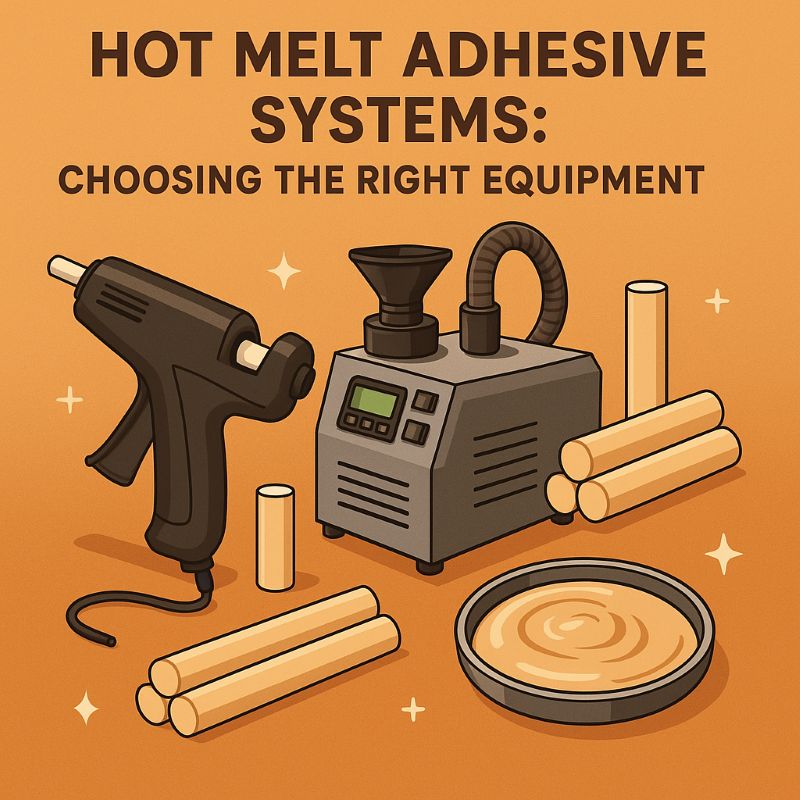
Understanding Hot Melt Adhesives
Types of Hot Melt Adhesive Systems
Importance of Equipment Selection
Methods for Equipment Evaluation
Latest Trends in Adhesive Systems
Strategies for Equipment Optimization
Challenges in Adhesive Systems
Frequently Asked Questions (FAQ)
Understanding hot melt adhesives is essential for choosing the right system to meet industrial needs. These adhesives are fast-setting, versatile, and suitable for various applications ranging from packaging to woodworking. When selecting equipment, it’s important to consider material compatibility, throughput, and application accuracy. High-performance dispensing systems designed for precision, flexibility, efficiency, or sustainability can help improve adhesive application outcomes, ensuring reliable bonding and operational excellence.
Hot melt adhesive systems come in several forms to suit different manufacturing environments.
Tank-Based Systems are ideal for continuous, high-volume production, offering stable adhesive flow.
Tankless Systems are known for reduced char formation and high precision, making them suitable for delicate applications.
Modular Systems with quick-change capabilities support flexible production lines with frequent adhesive or product changes.
Eco-Efficient Systems are engineered to minimize adhesive usage and energy consumption, aligning with sustainable production goals.
Energy-Saving Designs focus on reducing power usage without compromising adhesive performance.
Each system type serves unique operational objectives, and understanding these distinctions is critical for process optimization.
Choosing the right adhesive equipment directly impacts manufacturing performance, cost efficiency, and product quality. Key factors include:
Precision Needs: For consistent, clean bonding without excess waste.
Flexibility: Quick changeovers and adaptability to varying product runs.
Sustainability: Reduced adhesive use and energy-efficient operation.
By aligning equipment capabilities with production goals, companies can maximize productivity and meet evolving customer expectations.
Effective evaluation of hot melt equipment starts with defining application requirements—such as adhesive type, production volume, and desired bonding performance.
Real-world Testing helps assess reliability, consistency, and ease of use.
Performance Metrics like energy usage, changeover time, and waste generation should be tracked.
Environmental Impact must also be considered when comparing systems.
Whether aiming for energy efficiency, process flexibility, or material savings, methodical evaluation ensures the selected system is future-proof and scalable.
Several trends are shaping the next generation of adhesive application systems:
Sustainability Focus: Equipment designed to reduce adhesive consumption and environmental impact.
Tankless Precision: Systems offering exact control and minimal waste, ideal for high-accuracy operations.
Adaptable Equipment: Solutions that support fast product changeovers and flexible production lines.
Energy-Efficient Design: Lower power requirements without compromising output quality.
Staying ahead of these trends can drive competitiveness and long-term value across production lines.
To fully leverage hot melt systems, manufacturers can implement the following:
Define Operational Priorities: Match equipment with your specific needs (precision, flexibility, or sustainability).
Standardize Components: Simplify maintenance and reduce downtime with modular, universal parts.
Monitor Usage Patterns: Use data to adjust temperature, volume, and application timing for efficiency.
Train Operators: Ensure staff can manage, adjust, and troubleshoot systems to prevent performance drops.
Optimization is not just about machinery—it includes how people and processes interact with the equipment.
Common challenges in hot melt operations include:
Equipment Mismatch: Choosing systems that don’t align with production needs results in inefficiencies.
Material Waste: Excess adhesive usage due to poor control mechanisms.
Downtime from Complexity: High-tech systems without proper operator training can slow down operations.
Sustainability Pressures: Companies face growing demand for greener solutions.
Tackling these issues requires clear planning, proper system integration, and ongoing process reviews.
Q1. What are hot melt adhesives and their primary applications?
Hot melt adhesives are thermoplastics that bond quickly when applied in molten form. They are widely used in packaging, woodworking, automotive, filtration, and more due to their fast setting time and versatility.
Q2. What types of hot melt adhesive systems are available?
Options include tank-based systems for steady high-volume production, tankless designs for precision and cleanliness, and modular or eco-focused systems for flexibility and sustainability.
Q3. Why is equipment selection important in hot melt adhesive systems?
Proper equipment impacts bonding strength, cycle time, maintenance needs, and environmental performance—making it central to productivity and cost control.
Q4. How can one evaluate equipment for hot melt adhesive systems?
Evaluate by testing under real operating conditions, tracking energy usage, application consistency, and changeover times. Consider future scalability as well.
Q5. What are the latest trends in adhesive systems?
Trends include eco-friendly adhesive management, tankless precision systems, energy savings, and adaptability for shorter product cycles.
Q6. What strategies can be employed for optimizing hot melt adhesive systems?
Align systems with production goals, train operators, use real-time monitoring tools, and integrate energy- or material-saving technologies.
Q7. What challenges do businesses face in hot melt adhesive systems?
Issues include choosing the wrong equipment, high energy or adhesive waste, operational complexity, and sustainability compliance.
Q8. Can you recommend systems for different needs?
While specific brand names vary, choose systems designed for high precision in delicate tasks, modularity for flexible production, or reduced adhesive use for sustainability-focused operations.